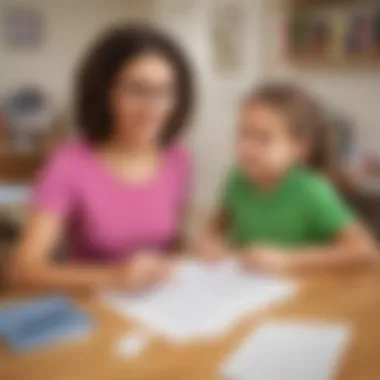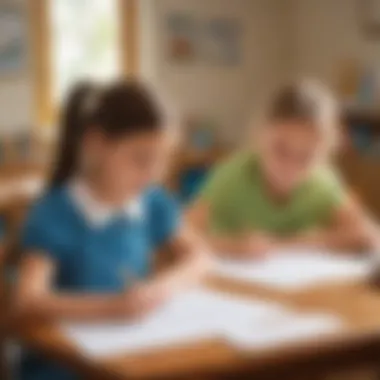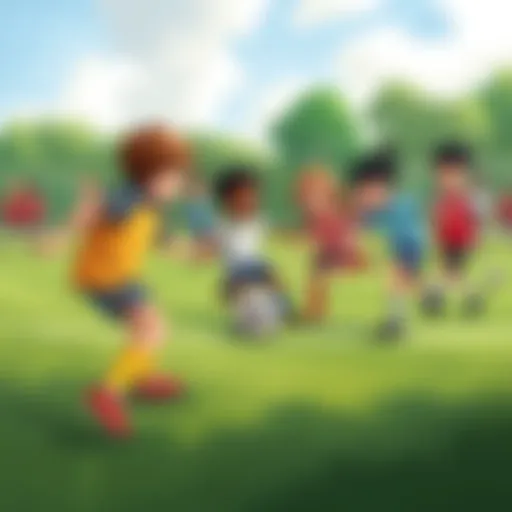Mastering Friendly Letter Format: A Guide for Parents


Intro
In today's fast-paced digital world, traditional writing skills often take a backseat. However, the friendly letter format provides an excellent avenue for children to communicate in a meaningful and structured way. This format not only encourages children to express themselves but also instills the importance of personal communication. Understanding this format is crucial for parents and educators aiming to enhance children’s writing abilities.
The friendly letter is versatile. It can be adapted for various occasions, be it a thank-you note, a birthday greeting, or simply checking in on a friend. By grasping the elements of a friendly letter, children can engage in rich, expressive writing that fosters connections and nurtures their interpersonal skills. This guide will present vital components and practical applications, facilitating adults in nurturing young writers.
Interactive Learning Games
While the focus is on writing friendly letters, integrating interactive learning games can enrich the learning experience and motivate children to enhance their writing skills.
- Popular Games
Some games stand out for their effectiveness in developing communication skills. These include: - Benefits of Playing Educational Games
Games offer various benefits:
- Scrabble: A classic game encouraging vocabulary development.
- Story Cubes: Fosters creativity and storytelling.
- Words with Friends: An online game promoting word formation while engaging with peers.
- Develops critical thinking.
- Facilitates teamwork.
- Enhances problem-solving abilities.
Game Reviews
In-depth reviews can assist parents and educators in selecting appropriate games for their children.
- Scrabble
- Story Cubes
- Gameplay: Players build words on a game board using letter tiles.
- Learning Outcomes: Improves vocabulary and spelling skills.
- Gameplay: Players roll dice featuring images to create stories, making it an engaging way to inspire writing.
- Learning Outcomes: Enhances creativity and narrative abilities.
Educational Topics
A strong foundation in letter writing intersects seamlessly with various educational topics.
It is essential to expose children to multifaceted subjects like math, science, and languages. This interdisciplinary approach encourages holistic development and broadens their understanding.
Tips and Tricks
For parents and educators, simple adjustments can make a significant impact on how children view writing.
- Practical Tips
- Strategies for Engaging Learning
- Set aside regular time for letter writing.
- Encourage kids to write letters to family members or friends.
- Provide stationery and colorful pens to make it enjoyable.
- Use prompts related to their interests.
- Create friendly letter templates to ease them into the format.
Creative DIY Projects
Hands-on activities can stimulate creativity and learning in children, reinforcing the skills needed for writing friendly letters.
Step-by-Step Guides
Creating DIY projects can be both fun and educational. For instance, making a letter writing kit can involve:
- Gathering supplies like paper, envelopes, and decorative items.
- Organizing materials for easy access.
- Creating a sample friendly letter together as a guide.
Craft Ideas
Simple crafts using household items can foster artistic expression.
A few ideas include:
- Designing custom envelopes.
- Creating handmade cards.
Artistic expression nurtures confidence and enhances fine motor skills, crucial for writing.
"Friendly letters not only teach children how to write but also how to connect with others effectively and meaningfully."
The process of writing and crafting improves overall communication, fostering relationships and enhancing critical skills needed throughout life.
Prologue to Friendly Letters
In the realm of written communication, mastering the art of friendly letters is a fundamental skill, particularly for children. This section aims to outline the significance of friendly letters, providing parents and educators with insights into fostering effective writing practices among young learners. The purpose of friendly letters extends beyond mere correspondence; it serves as an avenue for nurturing relationships, expressing gratitude, and cultivating social skills. When children learn to articulate their thoughts and feelings through letters, they gain confidence in their ability to communicate.
Defining Friendly Letters
Friendly letters are informal types of written communication sent to people with whom one has a personal relationship. This can include friends, family members, or acquaintances. Unlike formal letters, which adhere to strict guidelines and often serve a specific professional purpose, friendly letters allow for more relaxed expression. They typically feature a conversational tone, encouraging recipients to engage with the content personally. A fundamental aspect of friendly letters is that they contain specific components, such as the date, salutation, body, closing, and signature. Each of these elements plays a crucial role in presenting a complete and coherent message.
Importance in Communication


The importance of friendly letters in communication cannot be overstated. They help children develop a variety of essential skills. Writing friendly letters encourages youngsters to:
- Express Emotions: Children learn how to articulate their feelings, whether it's joy, sorrow, or appreciation.
- Enhance Writing Skills: Crafting letters aids in developing grammar, punctuation, and overall writing proficiency.
- Foster Connections: Friendly letters create bonds between individuals, encouraging continued dialogue in a digital-heavy world.
Moreover, friendly letters can serve educational purposes. They often require students to structure their thoughts clearly, making it a practice that can translate to other forms of writing. As children learn to write letters, they not only gain a sense of accomplishment but also begin to appreciate the impact of their words on others. In an increasingly digital age, where much communication happens via text messages or emails, the art of friendly letter writing remains relevant. It cultivates a personal touch that is often missing in fast-paced exchanges. Thus, understanding the format and components of friendly letters prepares children for a lifetime of effective communication.
Key Components of a Friendly Letter
Understanding the key components of a friendly letter is essential for anyone looking to help children develop their writing skills. Each part plays a critical role in constructing a letter that is clear, thoughtful, and expressive. When children grasp these components, they can communicate effectively and meaningfully. This understanding lays the groundwork for future writing, both personal and professional.
Date
The date sits at the very top of a friendly letter. It serves as a reference point, helping both the writer and the recipient understand when the letter was composed. This can be important for tracking correspondence over time. Children should learn to format the date correctly, as it typically appears in a month-day-year format. For example, a correct date might look like this: October 10, 2023.
Including the date also teaches children the significance of time in communication. Letters written for specific occasions or events become more meaningful when the date is included. It also gives the recipient context about the writer's perspective during that time.
Salutation
The salutation is essentially the opening greeting of the letter. It sets the tone for the rest of the communication. A friendly letter usually starts with "Dear [Name],". This personal touch helps establish a connection between the writer and the recipient.
Using the first name, or a nickname, can convey warmth and intimacy. Children should understand that this part is just as important as the content of the letter, as it welcomes the reader into the conversation. Factors such as the relationship between the writer and the recipient can influence how formal or casual the salutation should be.
Body
The body is the heart of the letter. Here, the writer shares thoughts, feelings, and updates. Children must learn to organize their ideas clearly and logically. It helps to break the body into paragraphs focusing on distinct themes or topics.
For example, if a child is writing to a grandparent, one paragraph might express gratitude for a recent gift, while another could share an exciting story about school. Encouraging children to use specific details can make their letters more engaging. Additionally, varying sentence lengths keeps the text lively and can help convey emotions more effectively.
Closing
The closing wraps up the friendly letter. It signals that the letter is coming to an end while reinforcing a positive connection. Common closings in friendly letters include phrases such as "Sincerely," "Best wishes," or "Love."
The choice of closing can reflect the relationship between the writer and the recipient. A simple "Best," may suffice for a friend, while a more affectionate sign-off may be suitable for family. It's crucial to teach children that this part, like the salutation, can set the tone for future correspondence.
Signature
The signature is the last component, where the writer signs their name. It may seem minor, but it offers a personal touch to the letter. Children should understand that their signature represents their identity and is an essential part of the communication.
They might even choose to include their nickname or an initial, depending on their familiarity with the recipient. A signature completes the letter and can sometimes express the writer's personality. Encouraging children to practice their signatures can also be a valuable exercise in developing their writing skills.
In summary, each element of a friendly letter contributes to its overall effectiveness. Teaching children these key components empowers them to communicate more thoughtfully. As they learn to structure their letters, they will build a critical skill that fosters deeper connections with others.
Structure of a Friendly Letter
The structure of a friendly letter is fundamental in conveying thoughts and emotions effectively. It helps to create a clear and organized message that the recipient can easily understand. The structure also serves as a guide for children to follow, ensuring they include all necessary elements when writing. This organized format is beneficial because it makes the writing process less overwhelming and encourages creativity within a defined framework.
Basic Layout
The basic layout of a friendly letter includes standard components: the date, the salutation, the body, the closing, and the signature. Each part plays a specific role in the overall presentation of the letter:
- Date: This is typically placed at the top right corner. It informs the reader when the letter was written and can help place the correspondence in context.
- Salutation: This follows shortly after the date. It includes a friendly greeting, usually starting with "Dear" followed by the recipient's name. It sets a welcoming tone for the letter.
- Body: This is the main section where the writer shares thoughts and feelings. It can contain multiple paragraphs, allowing the writer to express themselves fully.
- Closing: A polite way to end the letter. Common closings include "Sincerely," or "Best wishes," and should be followed by a comma.
- Signature: Finally, the writer's name is added at the bottom. This makes the letter personal and identifies the sender.
Overall, adhering to this layout instills a sense of structure that enhances clarity. It teaches children the importance of organization in their writing.
Paragraph Formatting
Proper paragraph formatting is essential in a friendly letter. Each paragraph should start with an indentation or simply a line break from the previous paragraph. This visually separates distinct thoughts or topics, making the content more digestible.
- Indentation: New paragraphs typically begin with an indentation to indicate the start of a new thought. This practice makes the letter neater and visually appealing.
- Line Breaks: Alternatively, leaving a blank line between paragraphs can also create clear divisions. This is effective in digital letters or casual settings.
In addition, each paragraph should focus on a single idea or theme. A well-structured paragraph usually contains a topic sentence followed by supporting sentences. This structure helps maintain coherence and aids understanding.
For teachers and parents, guiding children in paragraph formatting reinforces their writing skills. It encourages them to organize their thoughts clearly and convey their messages effectively.
*Effective communication relies on clarity and structure. The friendly letter format helps young writers achieve this while expressing their creativity.*
In summary, a well-structured friendly letter is essential for effective communication. The basic layout and proper paragraph formatting collectively enhance the readability and emotional impact of the writing.
Writing Techniques for Effective Letters
Writing friendly letters is more than just adhering to a structure. It requires certain writing techniques to express thoughts clearly and meaningfully. Applying effective writing techniques can greatly improve how children communicate through letters. This section aims to illuminate the importance of these techniques, emphasizing elements such as language clarity, tone maintenance, and content engagement. By understanding and implementing these skills, parents and educators can foster better writing habits in young learners.


Using Clear Language
Clear language is vital in friendly letter writing. It helps the reader understand the message without confusion. Children should be encouraged to use simple words that convey their thoughts accurately.
When clarity is prioritized, it minimizes ambiguity. It is particularly beneficial when children are writing to grandparents or other relatives who may not be familiar with slang or modern abbreviations.
Here are some tips for encouraging clear language:
- Avoid complex vocabulary: Suggest children use words they fully understand.
- Be concise: Encourage them to express ideas directly, avoiding unnecessary elaboration.
- Focus on structure: Remind children that a clear structure can support their language use, making their intent more understandable.
Promoting clarity enables effective communication and enhances writing confidence.
Maintaining a Friendly Tone
Maintaining a friendly tone is essential for creating warmth in a letter. This tone conveys caring, respect, and connection. A friendly tone is especially important in letters about sensitive topics or personal experiences.
To develop a friendly tone, children can follow these guidelines:
- Use the recipient's name: Address the person by their name or a nickname to create familiarity.
- Incorporate questions: Asking how the recipient is doing shows interest in their well-being.
- Use positive language: Words that express happiness or gratitude help create an inviting atmosphere.
By applying these principles, children will craft letters that resonate emotionally with their readers. This skill aids in building relationships and fostering empathy.
Engaging Content
Engaging content is crucial for maintaining the reader's interest. A friendly letter should not only convey information but also be enjoyable to read. When children present engaging ideas clearly, it encourages dialogue and strengthens connections.
Consider the following elements for crafting engaging content:
- Personal anecdotes: Sharing stories from one's life invites connection and creates a sense of shared experience.
- Expressive emotions: Encouraging children to share their feelings regarding events emphasizes authenticity.
- Questions and prompts: Leaving questions for the reader invites them to think and respond. This dialogue can deepen relationships.
Engaging content transforms a simple letter into an opportunity for meaningful communication.
By focusing on language clarity, tone, and engagement, children learn the nuances of effective letter writing. Each letter becomes not just a medium for messages but a vehicle for connection and expression.
Common Scenarios for Writing Friendly Letters
Understanding common scenarios for writing friendly letters is crucial in helping children engage in effective communication. Friendly letters serve various purposes, allowing children to express gratitude, invite friends or family members, apologize for an error, or simply share a thought. These situations enhance their writing skills and foster connections with others.
Thank You Letters
Thank you letters play an essential role in teaching children the importance of acknowledging kindness or support. Writing such letters offers a chance for children to reflect on the positive actions of others. This reflection not only strengthens relationships but also encourages gratitude-related behaviors. For example, if a child receives a birthday gift, a thank you letter allows them to express appreciation in a structured way. The format includes a heartfelt opening, specific mentions of the gift, and a closing remark. This encourages clarity and personal connection in their communication.
Invitations
Inviting someone to an event is an exciting occasion. Writing invitations can teach children to articulate their thoughts clearly and think about the recipient's feelings. Whether for a birthday party, a school play, or a special family gathering, invitations help children communicate important details. They must include key information such as the date, time, and location, as well as RSVP (Répondez s'il vous plaît) instructions. This practice not only fosters a sense of responsibility but also assists in social skill development, enhancing their ability to connect with others.
Apology Letters
Apology letters carry significant weight in teaching children to take responsibility for their actions. When disagreements or mistakes occur, a heartfelt apology can mend relationships. Writing an apology letter allows children to reflect on their mistakes and express sincere regret. This process can include an explanation of the situation, acknowledgment of their role, and a commitment to make amends. Such letters emphasize the importance of honesty and sincerity in communication, laying the groundwork for emotional intelligence.
Just Because Notes
Just because notes are a delightful way for children to connect without a specific reason. These notes are often spontaneous and can brighten someone's day. They may contain a simple thought or an uplifting message. Just because notes encourage creativity and expression, allowing children to write freely without structured guidelines. In doing so, they acknowledge friendships and connections, reaffirming their social bonds. This fosters a habit of reaching out and supporting one another, even in small ways.
Writing friendly letters enhances children's communication skills while encouraging meaningful connections.
Tips for Parents and Educators
When it comes to fostering effective communication skills in children, friendly letters serve as an engaging tool. This section elucidates various strategies that parents and educators can implement for encouraging letter writing among young learners. By employing these tips, adults can significantly enhance children's ability and willingness to express themselves through written correspondence.
Encouraging Letter Writing
Encouragement is key in developing any skill, including letter writing. Children may often see writing as a chore rather than a creative outlet. To counter this, parents and educators should promote writing as a fun and involving activity. Begin by creating a suitable environment. Having a dedicated writing space can make the process feel more special.
In addition, regularly suggest topics for letters. Consider engaging children in discussions about people they know, family members, or friends, and encourage them to write letters to these individuals. Remind them that what they share can create joy and strengthen relationships. This not only motivates them but also reinforces positive experiences about writing.
Providing Examples
Utilizing examples can greatly assist children in understanding the friendly letter format. Parents and educators should take the time to show children samples of letters. This could be as simple as showing personal letters or finding examples in books or online resources.


While explaining, point out the key elements such as the date, salutation, body, closing, and signature. Discuss each component briefly and highlight its purpose. This method helps demystify the format while making the process less intimidating for young writers.
For instance, sharing a heartfelt thank you letter or an invitation can illustrate how versatile friendly letters can be. Children learn better when they can visualize concepts, making examples essential in guiding their understanding and skills.
Creating Writing Prompts
Writing prompts can be an effective way to inspire children when they feel stuck or unsure of what to write about. Parents and educators can develop relevant, age-appropriate prompts that ignite curiosity and creativity.
Some examples of prompts include:
- Write a letter to someone you admire, explaining why you look up to them.
- Create a letter to your future self, talking about your dreams and aspirations.
- Send a letter describing your favorite day or your recent vacation.
Incorporating themed prompts aligned with holidays or special occasions can also be beneficial. For example, around Thanksgiving, a letter expressing gratitude can be quite meaningful. These prompts not only ignite creativity but also encourage children to think deeply and convey their thoughts clearly.
"The more children write, the more confident they become in their abilities to communicate."
Ultimately, the combination of encouragement, practical examples, and tailored prompts can lead to significant development in a child's writing skills. Through simple yet effective methods, parents and educators can empower children to embrace the art of letter writing, creating a foundation for ongoing communication skills that will serve them for life.
Digital vs. Handwritten Letters
In today's fast-paced world, communication methods are evolving rapidly. Understanding the distinctions between digital and handwritten letters is crucial for parents and educators who aim to foster effective writing skills in children. Both formats have unique attributes and serve different purposes. While digital letters offer convenience, handwritten letters bring a personal touch that can enhance communication. Recognizing these differences allows adults to guide children in choosing the appropriate format for various occasions and enhancing their writing capabilities.
Benefits of Handwritten Letters
Handwritten letters hold a significant value in communication. The act of writing by hand can lead to several advantages:
- Cognitive Engagement: Writing by hand involves intricate motor skills and requires more cognitive effort than typing. This engagement strengthens memory retention and enhances writing fluency.
- Personal Connection: A handwritten letter carries a sense of intimacy and thoughtfulness. It shows the recipient that the sender has invested time and effort into crafting the message. This can be particularly meaningful for children when thanking someone or expressing emotions.
- Improved Focus: Creating a handwritten letter reduces distractions typical of digital devices. Children can concentrate better on their thoughts and ideas, leading to clearer and more coherent writing.
- Expression of Creativity: Handwriting allows for individual expression through unique styles, colors, and designs. Children can personalize letters in ways that digital communication often limits.
Overall, handwritten letters nurture not only communication skills but also emotional intelligence.
Advantages of Digital Communication
While handwritten letters have their benefits, digital communication is increasingly prevalent. Understanding its advantages is also critical in this digital age:
- Speed and Efficiency: Digital letters can be composed and sent instantly. This is especially beneficial for urgent messages or when quick communication is necessary.
- Accessibility: With smartphones and computers nearly ubiquitous, digital communication is readily accessible to most individuals. This facilitates easier communication across distances, making it simpler for children to stay in touch with friends and family.
- Editing Capabilities: Digital formats allow for easy editing and revision. Children can draft their thoughts, receive feedback, and make changes without starting over, thereby learning to refine their writing.
- Inclusion of Multimedia Elements: Digital letters can incorporate images, videos, and links. These features can enhance the message and make communication more engaging and informative.
The Role of Friendly Letters in Education
Friendly letters serve a critical function in the educational development of children. They are more than mere notes or simple communications; they are tools that build essential skills and instill emotional intelligence. This section will detail the specific ways in which friendly letters contribute to a child's education.
Building Writing Skills
Friendly letter writing enhances various writing skills among children. When children engage in composing letters, they practice organizing their thoughts. They learn to structure their communications clearly, using proper grammar and punctuation. Moreover, writing friendly letters encourages vocabulary expansion. As children search for the right words to express their feelings or ideas, they enrich their language skills and enhance their overall writing proficiency.
Importantly, friendly letters teach children about audience awareness. Each letter has a specific recipient, which requires the writer to tailor their language and tone. Understanding who they are writing to fosters critical thinking about the context and purpose of their communication. This consideration of audience makes writing a more engaging and dynamic exercise.
Encouraging Empathy and Understanding
The process of writing friendly letters also promotes empathy and understanding among children. By encouraging them to express their thoughts and feelings, letters become a platform for emotional expression. Children learn to articulate their emotions, whether they are sharing gratitude, offering apologies, or simply checking in on a friend. This articulation fosters self-awareness and emotional intelligence.
Furthermore, when children write letters to others, they must consider the recipient's perspective. This not only cultivates a sense of empathy but also develops an understanding of interpersonal relationships. Writing letters encourages children to think beyond their immediate feelings and consider how their words impact others.
"Writing is an exploration. You start from nothing and learn as you go."
Closure
The conclusion serves as a vital component in reinforcing the main ideas discussed throughout the article on friendly letters. It brings together the essential elements, highlighting their significance in enhancing children's writing skills. By summarizing these key points, readers can better understand the impact of friendly letters on communication. Parents and educators will also appreciate the tangible benefits that arise from encouraging such writing practices among children.
Summarizing Key Points
In this article, we explored several fundamental aspects of friendly letters:
- Definition and Importance: Understanding what a friendly letter is and its role in effective communication.
- Key Components: Familiarizing oneself with the standard parts of a friendly letter including date, salutation, body, closing, and signature.
- Structure: Guidelines on how to layout and format a friendly letter for clarity.
- Writing Techniques: Employing clear language, maintaining a friendly tone, and creating engaging content that resonates.
- Common Scenarios: Recognizing opportunities for letter writing such as thank-you letters, invitations, apologies, and just-because notes.
- Tips for Encouragement: Strategies for parents and educators to promote letter writing in daily life.
- Digital vs. Handwritten: Weighing the pros and cons of these formats.
- Role in Education: Insights into how friendly letters can build writing skills and foster empathy in children.
By synthesizing these components, it becomes evident that friendly letters offer more than just a way to communicate; they provide a medium through which children can enhance their writing abilities and emotional intelligence.
Encouraging Continued Practice
To ensure children are comfortable with the friendly letter format, ongoing practice is crucial. Here are several strategies to keep in mind:
- Daily Writing: Encourage children to write letters regularly. This can be to friends, relatives, or even fictional characters. The more they practice, the better they will become.
- Set Challenges: Create fun writing challenges such as letter writing contests. This adds an element of excitement and motivation.
- Promote Real-World Connections: Encourage kids to send letters to family members or friends. They may find joy in the process, especially in receiving replies.
- Incorporate into Learning: Tie friendly letter writing into other subjects. For example, letters related to stories being read in class can enhance learning and comprehension.
- Provide Feedback: Take the time to read and respond to letters written by children. Constructive feedback can help them improve while instilling a sense of accomplishment.
These strategies ensure that the art of friendly letter writing remains a relevant and enjoyable practice for children, aiding in their overall communication development.
"Writing letters is not just about words; it's about connecting and expressing emotions."
By prioritizing this practice, parents and educators can lay a strong foundation for effective communication that extends beyond the classroom.















